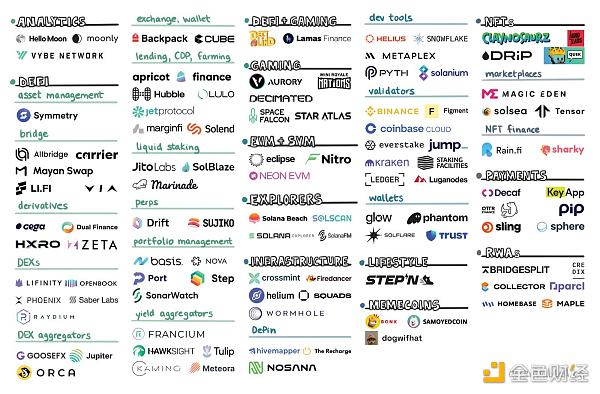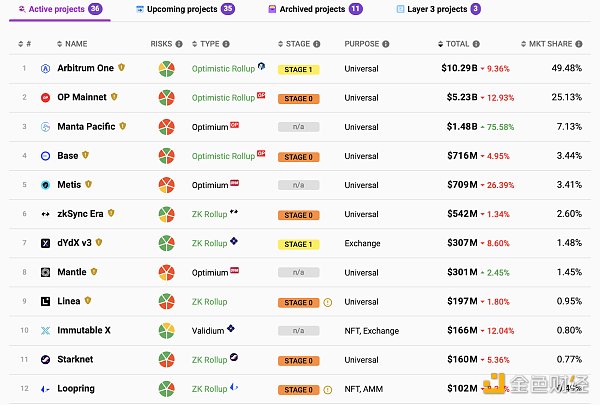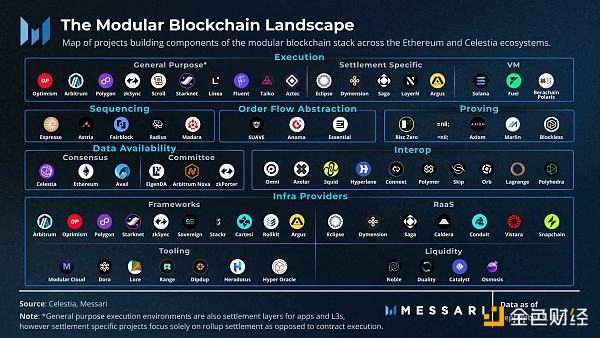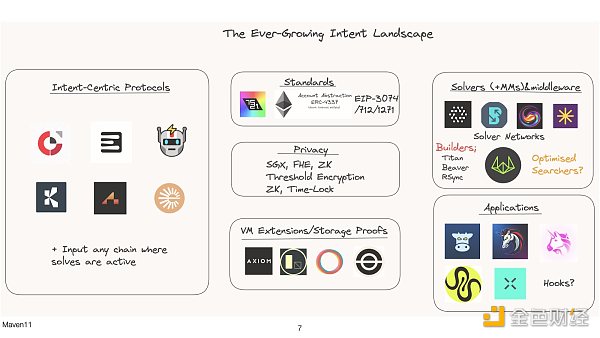Author: Arjun Chand, Bankless; Compiler: Deng Tong, Golden Finance
Cryptocurrency is booming again. All the signs of a bull market are here. The coin increased 2x overnight. The CT timeline is full of "I gave you x for $69 before it was done 1000x" posts.
However, there is usually a quiet time before such excitement. This is when the real bull markets happen. This time is no exception.
Back in November 2021, Bitcoin reached $69,000 and Ethereum hit $4,800. The total value of cryptocurrencies topped $3 trillion. Everyone thinks cryptocurrencies are the future of finance, and the growth seems unstoppable. But unfortunately, that was the small top of the last bull market. Over the next two years, the market continued to decline. We entered a bear market and bottomed out in November 2022, marked by the collapse of FTX.

A bear market may look like It’s frustrating, but it’s not all bad news. Yes, prices are down hard and cries of “cryptocurrency is dead” are still echoing, but what does that say?
The bear market attracts builders, builders create projects with product-market fit, products with PMF attract new users and investors, adoption leads to speculation that cryptocurrencies are the future of finance, and a new bull market begins .

People feel strongly Well, we are now just before the real bull market takes off. If you listen to Anonymous at Penguin PFP on X, they'll tell you the past few months have been just a preview of the wild ride we're in for.
However, this article is not about the upcoming bull market and how you should prepare. This is to celebrate the builders who stayed through the crypto winter and built solid projects. Today, we'll focus on some of the key sectors that developed during the bear market.
Solana's glorious return
There are usually multiple ways to achieve your goals. Solana’s comeback story is a powerful reminder that there are different approaches to achieving mass adoption.
Remember when we mentioned that the bottom of a bear market was marked by the FTX crash? Our builders’ cry for ecosystems seems appropriate, with many fearing ecosystem collapse will follow.
Solana’s comeback story is nothing short of a miracle, and one the entire industry is celebrating.
Solana Virtual Machine (SVM) is turning heads, and for good reason. The "Only Possible on Solana" tag is more than just a MeMe thanks to its local fee market mechanism that keeps gas prices low. SVM’s reach is expanding beyond Solana. Modular Rollups like Eclipse are adopting it, Ethereum heavyweights like MakerDAO are considering it for their own native chains, and innovative projects like Rome Protocol are using it to solve Ethereum’s scaling challenges.
On the application side, Solana has feature-rich platforms like Jupiter and Tensor that are redefining the user experience in DeFi. The great user experience of the Solana app continues to be the network’s low fees and fast transaction execution.

In addition to diverse Outside of the app ecosystem, Solana has fostered a loyal community with a unique culture. From NFTs like Mad Lads and Tensorians to Memecoins like BONK and Dogwifhat, transforming the ecosystem into a live casino — and not forgetting airdrops like JTO and JUP that create instant wealth for users — Solana has all the makings of a standout player in the bull market.
Layer2 value-added
The Ethereum community has a dream, a dream to scale through L2 so that users can conduct cheap transactions. Now, as L2 is scaling Ethereum approximately 5x, this dream is becoming a reality.
L2 is key to Ethereum’s success and scalability. A number of projects are launching in 2021, with some speculating that their launches are boosting ETH and several ETH ecosystem tokens as Ethereum’s Rollup-centric roadmap unfolds, showing a clear path to scaling. of rise. Since then, L2 has seen impressive growth. Here are some statistics showing L2 is a major success story in the bear market:
As of January 2024, L2 handles 5x the daily transaction volume of Ethereum.
On February 21, 2023, Arbitrum became the first in a daily event Rollup surpassed the Ethereum mainnet and later reached 2.5 times the transaction volume of Ethereum after the $ARB airdrop.
In December 2023, zkSync Era became the first Rollup to process more transactions than Ethereum in 30 days.
By April 2023, the total TVL of all L2s exceeded $10 billion for the first time, doubling to $20 billion by January 2024.
Currently, there are 4 L2s with over $1 billion in TVL, one of which (Blast) is not even online yet. There are currently 12 Rollups in production, each with a TVL of over $100 million. Arbitrum is in the lead with TVL of over $10 billion (50% market share), while Optimism is in second place with over $5 billion (25% market share).

With danksharding (EIP-4844), data availability solutions (Celestia, EigenDA, Avail), Rollup frameworks (OP Stack, Arbitrum Orbit, ZK Stack, Polygon CDK) and Rollup as a Service providers (Caldera, Conduit) (AltLayer), we may see thousands of Rollups deployed by 2024.
The ease of Rollup deployment means teams will experiment to stand out. We’ve seen this with Rollups like Blast and Manta Pacific, which offer native yields for holding funds on their chain.
Modularization, not maximalism
In the era of modular blockchain, high Gas Cost is no longer a barrier to building cool things on Rollups. Rollups can now scale by storing data in different layers outside of Ethereum.
Modular blockchains, which deconstruct the various layers of the blockchain (execution, settlement and data availability) into specialized chains, made significant progress during the bear market and are now seeing early adoption.
There is innovation at every level. For example, at the execution layer, teams such as Monad and Sei are working on parallelizing the EVM to improve throughput. Meanwhile, teams like Aptos, Sui, and Movement Labs are developing new programming languages such as Move for blockchain and smart contract development.
The data availability (DA) layer is particularly interesting these days. Celestia’s mainnet launch in October 2023 officially kicked off the DA war. Major ecosystems such as Starknet, Eclipse, and Manta, as well as L3s such as Lyra and Aevo, have begun integrating Celestia into DA, signaling a trend that may shape the future as more chains launch with Celestia support.
Other DA solutions expected to launch in 2024, such as EigenDA and Avail, will provide chains with multiple DA options. Coupled with Ethereum's own prototype danksharding (EIP-4844) (expected to go live in 2024 and aimed at reducing L2 DA costs), it will be interesting to see whether the chain sticks with using Ethereum for DA or moves to a dedicated DA layer. Very interesting thing.

The future is multi-chain Also a cross-chain
bridge in cryptocurrency: It is a legend that connects different chains. We might prefer a world without them, but the fact is that they are integral to multi-chain ecosystems.
In 2022, Vitalik Buterin shared his view that the future will be multi-chain but not necessarily cross-chain, citing security issues with bridging. However, as we have seen time and time again, both users and capital move towards the most profitable opportunities. As adoption of different chains increases, there is an inherent need for users and capital to flow within these ecosystems, leading to significant developments around interoperability solutions such as messaging protocols and liquidity networks that support the movement of data and assets.
Key innovations developed during the bear market to support this cross-chain functionality include:
Messaging protocols - These protocols enable smart contracts on one chain to receive data from other chains. Major players in this space include LayerZero, Axelar, Wormhole, Chainlink CCIP, and Circle CCTP.
Liquidity Networks – Also known today as intent-based bridges, these networks facilitate the transfer of assets between chains. Leading solutions include Across, Stargate and THORChain, as well as aggregators like LI.FI and interfaces like Jumper to help users find the best route for cross-chain transactions.
Cross-chain applications – These are blockchain-agnostic applications built on messaging protocols. Popular examples include liquidity networks like Squid with Axelar, Stargate with LayerZero, and various applications such as the Radiant Capital money market on LayerZero or the Prime Protocol lending platform on Axelar.
Cross-chain token standards - These standards ensure token fungibility across blockchains, enabling seamless cross-chains through burning and minting mechanisms supported by messaging protocols transmission. Notable standards include LayerZero’s OFT, xERC20, Wormhole’s xAssets, and Axelar’s IST.
Multi-chain compatible tools - The reality of multiple chains requires the development of ecosystem tools. This includes apps and wallets with built-in cross-chain transactions, as well as multi-chain-enabled dashboards, analytics platforms, and blockchain explorers to enhance the DeFi user experience in a multi-chain environment.
The need for cross-chain governance from platforms like Uniswap, Lido’s cross-chain expansion to wstETH, and the billions of transaction volumes handled by liquidity networks have all highlighted messaging The importance of protocols and liquidity networks in multi-chain ecosystems. As concepts such as hyperchains leveraging OP Stack and Polygon's converged blockchains develop with Polygon CDK, the role of these interoperability solutions will be interesting to watch. Additionally, with the ease of deploying Rollups, we are moving towards a future with thousands of chains. As the ecosystem continues to expand, observing how these solutions adapt and perform at scale will be a key area of focus.
Intentions illuminate the DeFi dark forest
Intentions are all here. The foundation has been laid for today’s intent system with its limit orders, aggregations, batch auctions, and solvers. They are laying the foundation for future advanced intent protocols, promising MEV protection, advanced aggregation, intent standards, and privacy that will simplify the use of DeFi for everyone.
The concept of “intention” was introduced into the mainstream through a speech and became the buzzword of 2023.
Simply put, intent is the outcome a user wants to achieve by interacting with an application. This is not a new concept; intention has always been a part of user experience, albeit in a rudimentary form. For example:
Uniswap facilitates the intention to exchange asset X for asset Y.
Opensea caters to the intent of purchasing NFTs.
1inch addresses the intention of exchanging assets at the best interest rate.
These examples represent a basic level of intent that focuses on fulfilling the user's desires but still requires the user to deal with the complexities of transaction execution.
In the intent-based paradigm, users communicate their desired outcomes without detailing the execution process or setting limits on potential benefits. Third-party agents called solvers then execute these intents and compete in the intent protocol. They are influenced by auction and game theory incentives to deliver the best possible results to win over user-generated order flow.
This approach significantly enhances the DeFi user experience, providing greater flexibility and customization while abstracting away complex execution processes. The importance of this becomes even more apparent in an environment with thousands of chain stores, where this kind of user-centric flexibility can make users' lives easier.
While the concept of intentions is starting to gain popularity in 2023, projects like CoWSwap, 1inch Fusion, and Across have already laid the groundwork. As intent-based applications become more popular, the role of solvers will become critical. They are the architects of user intent.
In addition, intent-centric protocols such as SUAVE, Anoma, and Essential have been in development for years and are about to be launched. These protocols are exploring intent at a larger scale, delving into order flow, solvers, MEV, domain-specific languages, block building, decentralization and value extraction, breaking through by engaging with these concepts deeper within the blockchain stack limit.

The evolution of intentional landscape It’s a development worth watching closely in the coming years. For those interested in exploring intent in more depth, the Flashbots team has created a comprehensive dashboard at orderflow.art that provides valuable insights into this emerging field.
Other key developments in emerging industries
As we conclude this article, it is important to recognize that Several other industries that have experienced substantial growth over the past two years and are expected to have a significant impact on the future landscape:
Re-staking - Following the Ethereum merger in 2022, liquidity staking of assets such as ETH has become a cornerstone of DeFi. Projects like ETH’s Lido (stETH) and Rocket Pool (rETH) and SOL’s Jito have garnered billions of dollars in value. Liquid staking has been a trend before 2023, but now re-staking has become a new frontier in DeFi. An ecosystem led by Eigenlayer is growing around restaking, with projects including Ether.fi, KelpDAO, and Swell, among others. These initiatives enable users to earn additional rewards by re-staking their tokens using protocols like Eigenlayer, which leverages these assets to secure various parts of DeFi infrastructure, such as the DA layer with EigenDA.
Real World Assets (RWA) – The idea of tokenizing everything and putting it on-chain may be a meme, but significant progress has been made in this space. Efforts to tokenize tangible assets such as real estate and income instruments such as U.S. Treasury bills are underway. Projects such as Ondo, Parcel and LandX are leading the way.
Blockchain Gaming – The on-chain gaming industry is experimenting with some novel concepts, such as earning money by playing games and ownership of in-game assets. Early successes like Axie Infinity bode well for a bright future, and after years of development and investment, this breakthrough game has the potential to attract a wave of new users. Ecosystems like Avalanche and Polygon are strategically positioning themselves as the platforms of choice for game deployment. Keep an eye out for projects like Immutable and Beam in this vertical.
Artificial Intelligence (AI) – This field aims to merge two of the most radical innovations in recent decades: cryptocurrencies and artificial intelligence. Although still in its infancy, we can expect a surge in activity as projects begin to enter the market. Projects like Bittensor and Olas pioneer the integration of artificial intelligence with the decentralized ethos of cryptocurrency.
Decentralized Physical Infrastructure (DePIN) – This area has the potential to attract mainstream attention to cryptocurrencies. By applying decentralized principles such as transparency and community governance, the DePIN project aims to create a fairer system for physical infrastructure use cases. For example, imagine a community-owned and operated alternative to Google Maps. DePIN protocols like Hivemapper are making this concept a reality, connecting real-world drivers to encryption-based mapping infrastructure to compensate them for mapping roads around the world.
That’s it for today!
Bear markets have always been a hotbed of innovation, and while we've covered a lot, there's undoubtedly more to be discovered.
 Huang Bo
Huang Bo
 Huang Bo
Huang Bo CharlieXYZ
CharlieXYZ
 Bitcoinist
Bitcoinist Bitcoinist
Bitcoinist Bitcoinist
Bitcoinist Bitcoinist
Bitcoinist Cointelegraph
Cointelegraph 链向资讯
链向资讯 Cointelegraph
Cointelegraph